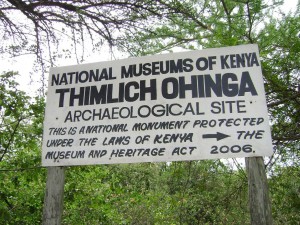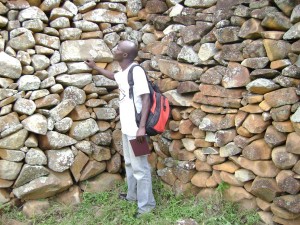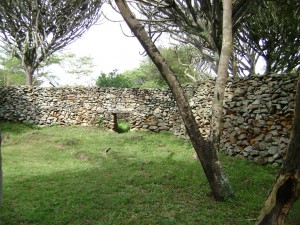By Nick Oluoch
Travelstart Blogger Experience Competition
Thim Lich Ohinga, a Luo word loosely translated into a frightening dense forest and a fort, has for sometimes now elicited just as much interest as curiosity from adventurers, archeologists, and architectures alike.
Made up of stone walls ranging from a meter to about four and a half meters, this structures not only epitomes the art of architecture in the olden days, but also has got a near perfect combination of beauty, strength and balance.
Situated just out of Migori town, deep into the west of the country towards the shores of Lake Victoria at Sori, this historical site has almost striking resemblance to the ruins of the great Zimbabwe in southern Africa.
Thim lich has always been a source of different researches, none yet to come up with the exact explanation of how the ancient man, always rebuffed for his perceived ‘backwardness; could have come up with a near perfect art.
Getting in, I have to kneel before making my way in. Silas tells me that the entrance was made intentionally shorter.
‘The doors were made short intentionally to ensure that by the time the enemy got inside, he was less stable as he was still bending. The guards could then easily overpower him.” He says
He moves to the games section. Here, stones where the men are believed to have played ‘ajua’ games are still intact. Besides them are the grinding stones where the women are believed to have ground the grains while the men played.
A couple of monkeys make their way past where we are standing barely noticing us though they scamper away the moment I take my camera out. He informs me that this place, that’s so enchanting to any visitor, was back in the year 2002 listed as number forty eight among the most endangered sites in the world.
As we leave the fort and into the nature trail surrounding the fort. An antelope passes strangely in a company of a number of monkeys some meters from where we are.
Soon, we are deep into the forest. This, I am told is where the residents of the fort would run and come into whenever they had been overpowered in a fight inside the fort, something that never got to happen during their stay there.
The air in the forest is scented with herbs and wildflowers that proliferate on this area and the mountainous interior is further adorned with slender cypress trees and cider. In fact, so varied and colourful is the landscape that I believe this is the best part of the fort to explore, especially on foot.
Just outside the fort, the timeless rhythm of agricultural life has changed little and verdant, fertile valleys-such as the great vale of Sori just along the banks of river kuja can still be seen with crops germinating well. During this time, we come across more antelopes, monkeys, and even a number of guinea fowls. The journey is also punctuated with endless shrills of the birds throughout the trip.
There are actually four forts in here’ he offers in a matter of fact ways. He explains that the four homes, known as Kochieng, kakuku, Kokech and Koluoch combine to make the Thim Lich Ohinga.
This is another beautiful part. From the beautiful canopy being formed by the trees, verdant fertile land, which was the reasons people, settled into the forts in the first place, coupled with the stunning mountainous scenery of Macalder gold mines, one of the oldest gold mines in the region glittering above the home, the home is simply breath taking.
Next to the homes stands a smaller one which, as Silas explains, belonged to one of the settlers who was allowed to put up a home within the fort due to the forts’ perceived security. So the locals were not mean people, he hasten to add.
We soon come across a newly dug hole just at the center of the home. ‘This was due to an excavation process’ He informs me. I get to learn that there are still a number of researches being carried out to determine what really used to happen in this place.
Soon we are in the clearing, just at the entrance of the fort. Here three grass thatched houses stands. Silas explains to me that one of the houses has been made to show how the houses in the fort used to be.
It is almost time to leave but Silas asks me to accompany them for lunch, which as I would have expected, has got fish as one of the major ingredients. I am late but he tells me it is un African to decline food offer and so we eat before I leave the Nyanza’s fort Jesus.





Breathtaking. I have to vissit this place one of these days, I swear.
Quite interesting. Like your style of writing. Should do much more travel writing.